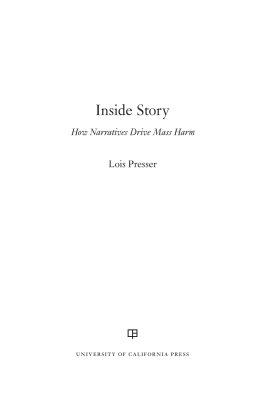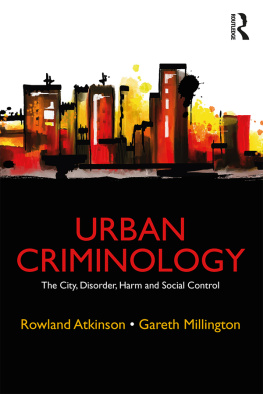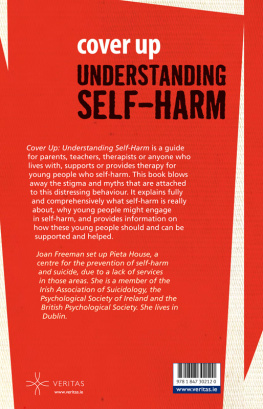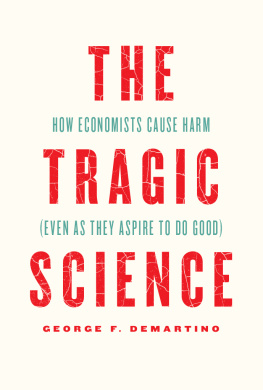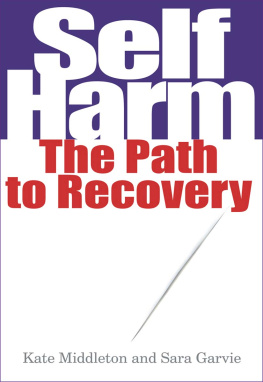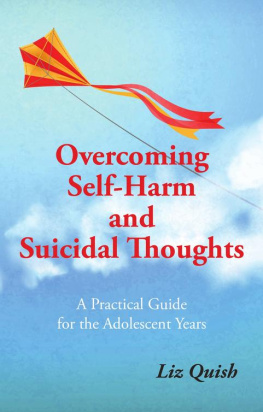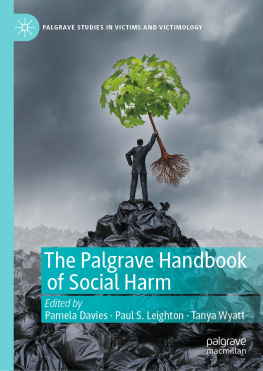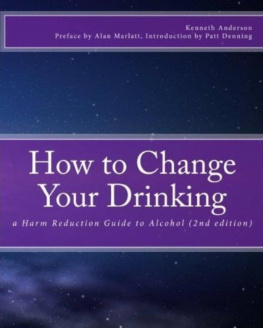Inside Story
Inside Story
How Narratives Drive Mass Harm
Lois Presser

UNIVERSITY OF CALIFORNIA PRESS
University of California Press, one of the most distinguished university presses in the United States, enriches lives around the world by advancing scholarship in the humanities, social sciences, and natural sciences. Its activities are supported by the UC Press Foundation and by philanthropic contributions from individuals and institutions. For more information, visit www.ucpress.edu.
University of California Press
Oakland, California
2018 by The Regents of the University of California
Library of Congress Cataloging-in-Publication Data
Names: Presser, Lois, author.
Title: Inside story : how narratives drive mass harm / Lois Presser.
Description: Oakland, California : University of California Press, [2018] | Includes bibliographical references and index. |
Identifiers: lccn 2018017428 (print) | lccn 2018020178 (ebook) | isbn 9780520964471 (ebook) | isbn 9780520290174 (cloth : alk. paper) | isbn 9780520290181 (pbk. : alk. paper)
Subjects: lcsh: CrimeSociological aspects. | Crime in popular culture. | Criminal psychology. | Violence.
Classification: lcc hv6025 (ebook) | lcc hv6025 .p664 2018 (print) | ddc 303.6dc23
LC record available at https://lccn.loc.gov/2018017428
27 26 25 24 23 22 21 20 19 18
10 9 8 7 6 5 4 3 2 1
Contents
Preface
The populism that has enraptured large segments of the populations of democratic societies is a main source of inspiration for this book. The question that is central to the bookWhat accounts for the emotional grip of stories?is a question I want to ask of the current popular movements that support autocracy, nativism, and racism. If ever a historical moment presented itself as requiring a sociological exploration of ideologically powered zeal, that moment is now.
Donald J. Trump was elected president of the United States when I was nearing completion of the book. Both during the presidential campaign in 2016 and after the election, in 2017, stories swirledabout Trump and his rival Hillary Clinton, foreign interference in electoral politics, corruption, treason, election fraud, tax fraud, corporate greed, secret surveillance, child sexual abuse, adult sexual abuse, government regulations and jobs, terrorists and other criminals crossing our borders, and about who and what America is and ought to be and what Americans need. No narrative was too far-fetched or improbable. We are spellbound by the stories of our times, both the stories we judge to be false and those we judge to be true. And we are stunned by the discoverya new one, it seems, for a broad public and even many political expertsof the real-world impacts of peoples stories.
If the spectacle and impact of todays stories have stimulated my thinking, they have also at times been exhausting. For deeply felt support I want to thank Linda and Larry Blair, Michelle Brown, Michelle Christian, Julia Chu, Reuben Danzing, Emily Gaarder, Carol Nickle, Joey Presser, and Jon Shefner. My resistance friends Jenny Jones, Deloris Mabins, and Charlene Negendank and my Heska Amuna community have truly sustained me.
I am also indebted to the International Society for the Study of Narrative for literature recommendations, to the Culture and Animals Foundation for financial support, and to the University of Tennessee for a faculty development leave. I gained immeasurably from a month in residence at the University of Oslo alongside Sveinung Sandberg, Thomas Ugelvik, and Ingvild Knvelsrud Rabe, and many wonderful others, of that fine institution. Maura Roessner of the University of California Press was unsparing with encouragement and guidance.
I am especially grateful to my children, Ansel and Halen Presser, and glad for the story we are developing together about fairness, compassion, and love.
CHAPTER ONE
Introduction
Narratives and Narrative Impacts
In October 2016 a story began circulating online about goings-on at Comet Ping Pong, a Washington, DC, pizza restaurant. According to the story, the restaurant was a staging ground for a human trafficking and child sex abuse operation run by presidential candidate Hillary Clinton and her campaign manager. On December 4, 2016, a North Carolina man named Edgar Welch stormed the restaurant with an assault rifle and took aim at employees, intent on rescuing the abused children and exposing the operation (Kang and Goldman 2016).
The tales people hear and tell inspire them to take action that is more or less consequential and more or less bold. We vote, demonstrate, and perpetrate violence on the basis of shifting accounts of being in the world. We also choose jobs, friends, and life partners; decide where to live and which groups to join; and decide to quit, alter, endure, or appreciate whatever path we have chosen. Remarkably, stories get masses of people to believe in and commit to the same things. What gives stories their power? This book explores the capacity of stories, or narratives, The book builds narrative criminology, or the study of the relationship between narratives and harmful actions and patterns (Presser 2009; Presser and Sandberg 2015). My goal is to suggest precise ways of thinking about how narratives promote actions and specifically though not exclusively harmful actions in which large numbers are affected and large numbers are implicated.
As far as arousal goes, there is nothing special about the story that motivates our participation in harm-doing, as opposed to other stories. I am roused, for instance, by a story of having neglected a friend, compelling me to send her a gift. This book sets aside the nature or content of harmgenic stories in order to concentrate on mechanisms of narrative sway.
NARRATIVE IMMERSION
Those who study reading, mostly literary scholars and psychologists, observe that we get lost in (Nell 1988) or seduced (Chambers 1984) or transported (Gerrig 1993) by narratives. Reading can put us into a sort of trance, hence the witchery of stories (Gottschall 2012; Nell 1988). When we are absorbed in this way, we notice fewer inaccuracies in the story, and we evaluate protagonists more positively (Green and Brock 2000). Green, Garst, and Brock (2004) propose that narrative operates as a cue to a reader to engage in a less-critical, more immersive form of mental engagement (p. 165). The experience of immersion in narratives brings about partial isolation from the facts of the real world (Gerrig 1993, p. 16). Beyond ideational impacts, those who research narrative impacts emphasize emotional arousal (Harold 2005; Hogan 2003; A.M. Jacobs 2015; Nabi and Green 2015; Oatley 2002; Polichak and Gerrig 2002; Tan 1996). Indeed, narratives emotional influence may be preeminent, as Green and Brock (2002) state: Individuals are swept away by a story, and thus come to believe in ideas suggested by the narrative (p. 325). A good story gets us feeling excited, anxious, disgusted, saddened, or satisfied. We identify and empathize with fictional characters: we come to feel what they feel (J. Cohen 2001; cf. Keen 2007). Absorbed in fiction, we become active participants in the storied events (Iser 1972, 1978; Polichak and Gerrig 2002).
Scholarly investigation of narrative impacts deals mainly with the verbal arts, or literature. It concerns fictional stories recounted by others almost exclusively. But comparable impacts are evident whether the story is fiction or nonfiction (Green, Garst, and Brock 2004; Strange and Leung 1999) and whether the story is received or told. Hence Torossians (1937) assertion: The difference... between aesthetic and practical emotional experience is not very great. The same psychological factors of memory and association, as well as those already discussed, are involved in both; except that in a practical experience the feelings aroused are identified with the individual having the experience, whereas in an aesthetic experience the feelings aroused are identified with the contemplated object (p. 25). A storied reality takes hold of us at all times. And we regularly tell stories about ourselves, in the form of statements we make self-consciously and the internal and virtually uninterrupted monologue of which we are barely conscious (Brooks 1984, p. 3). Psychologist Victor Nell (1988) notes that a narrative continues to exercise its fascination if teller and audience are condensed into one person and the act of telling is reduced to silence (p. 61).
Next page
